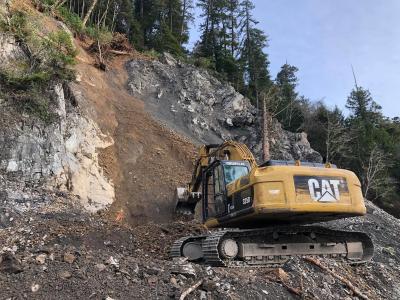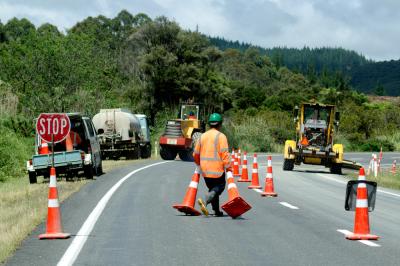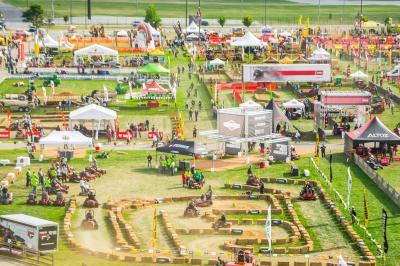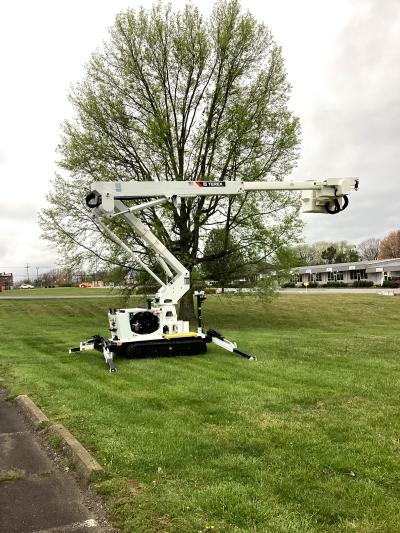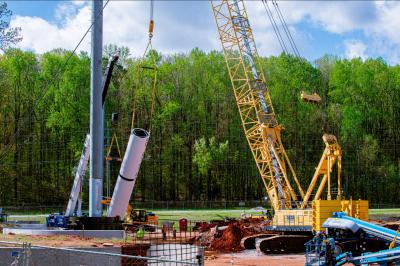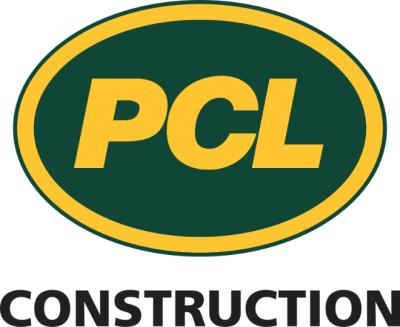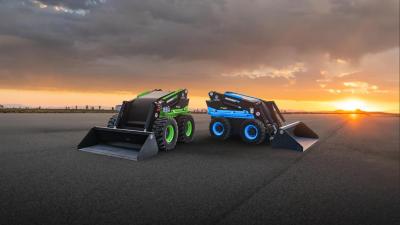Safety was a key factor in reconstructing a 3.5 mi. (5.6 km) stretch of Interstate 90 and approach slabs for eight bridges at Exit 30 at Sturgis, S.D.
The project took place from the Lawrence County line at Exit 28 to just west of the Exit 32 interchange in the northern Black Hills of South Dakota on the western edge of the state.
A curve at Exit 30 and a narrow 30-ft. bridge caused some safety issues that needed to be addressed, said Brenda Flottmeyer, lead project engineer of the South Dakota Department of Transportation.
The eight bridges needed more work than mainline paving, added Tom Stalley, project manager in the heavy highway division of Heavy Constructors Inc., of Rapid City, S.D., the prime contractor on the project. Four of the bridges received epoxy chip seal overlays while the other four were topped with a concrete overlay.
The 3.5 mi. portion of Interstate 90 was restored by removing the surfacing and installing new concrete pavement to a thicker depth of 11.5 in. (29.2 cm) which is the new standard, Flottmeyer explained. The existing pavement had a depth of 8 or 9 in. (20.3 cm or 22.8 cm), Stalley said.
“The depth was beefed up to the 11.5 inches because of a combination of soil types and truck traffic, which have greater weight limits. The thicker concrete slab also creates a longer life cycle than the thinner slabs,” said Stalley.
The paving portion ties in with two previous projects, creating a completely new road at Sturgis, Flottmeyer added.
Eastbound lanes were reconstructed during the first year of construction and westbound lanes were reconstructed during 2010.
During the 2009 work season crews also:
• Constructed median crossovers and temporary ramps at Exit 30 off and on ramps.
• Constructed a new approach and sleeper slabs, and applied an epoxy chip seal to the existing bridge deck surface on the eastbound structure at Bear Butte Creek.
• Constructed new approach and sleeper slabs and installed a nonmetallic fiber reinforced concrete overlay on the bridge deck surface on the eastbound structure at Exit 30 over Highway 14A.
• Constructed a new approach and sleeper slabs, repainted the bridge girders, and installed a low slump dense concrete overlay on the bridge deck surface at the eastbound structure of the DM & E Railroad.
• Removed the existing rubberized asphalt chip seal from the bridge deck surface and applied an epoxy chip seal on the eastbound structure over the County Road.
• Constructed median crossovers and upgraded detour route surfacing in preparation for the 2010 project work.
Very few materials needed to be hauled out of or onto the project site.
Stalley said that the subgrade preparation was done by removing the existing concrete slab and salvaging that material for reuse. The exiting base was scarified and recompacted and topped with a new base and 11.5 in. of concrete.
“The only materials brought in were concrete paving and minor bits of base course here and there,” Stalley said. “We worked it out that once the existing concrete was off we windrowed the gravel and did surface work and brought the gravel back on top.”
Subgrade work was done on half the roadway at a time, and only about 1,000 ft. (304.8 m) of grading work was needed.
Flottmeyer added that the majority of the project required no grading. The concrete and the granular material was removed and the base surfacing was replaced.
Crews performed the subgrade preparation using Cat 14 blades, scrapers for the borrow work, side dumps for hauling, Bidwell for the finishing work and Gomaco paving equipment.
Some borrow, about 7,800 sq. yds. (6,522 sq m), was needed where the bridge was widened, Flottmeyer said. About 109,000 sq. yds. (91,138 sq m) of mainline concrete was needed, along with 45,204 steel dowel bars to adjoin the pavement, creating 24 joint spacings, she added.
The South Dakota Department of Transportation tried a different type of overlay on Exit 30, using a fiber overlay on those two bridges, Flottmeyer said. “This is something we typically don’t see in this area but we’re trying to determine if we can use this process with the extreme freeze/thaw cycles in South Dakota. Typically we use low-dense bridge overlay.”
The overlay is similar to what is typically used but in this case the ready mix plant added fibers to improve the tensile properties, which the Department of Transportation hopes will cause less cracking and a less porous surface, she added. “We’re trying to protect our bridge decks and extend their service life with an impermeable surface, which will protect the road surface from road salts and chemicals that are applied during the winter season.”
During 2010, the second year of the project, crews:
• Constructed a new approach and sleeper slabs, and applied an epoxy chip seal to the existing bridge deck surface on the westbound structure at Bear Butte Creek.
• Widened the structure, constructed new approach and sleeper slabs, and installed a nonmetallic fiber reinforced concrete overlay on the bridge deck surface at the westbound structure at Exit 30 over Highway 14A.
• Constructed new approach and sleeper slabs, repainted the bridge girders, and installed a low slump dense concrete overlay on the bridge deck surface at the westbound structure of the DM & E Railroad.
• Removed the existing rubberized asphalt chip seal from the bridge deck surface and applied an epoxy chip seal to the westbound structure over the County Road.
• Removed median crossovers, permanent pavement markings, guardrails and signing.
The $11.6 million project proceeded relatively well with just a few issues. Traffic was routed head to head on either the westbound lane or the eastbound lane, depending on which half of the project was being constructed, Stalley said, so there was no traffic to contend with.
However, detours caused some confusion for motorists.
“The unique part of the whole traffic control scheme is there is a rail road on the east side of the Exit 30 bridge and so during the construction different access points were used for the ramps, which was a little confusing for local traffic,” Flottmeyer said. “During the first phase of construction, traffic had to be routed down a service road to the Interstate, which is 1,200 feet past where traffic would normally enter the Interstate.”
During the second phase of construction, traffic was routed beyond the Exit 30 on-ramp to access another service road west of Sturgis; this caused a lot of people, while trying to figure out the detour, to make u-turns on the Interstate, Flottmeyer added.
Before bid letting took place the detour route was proposed to take the detour to the Whitewood, S.D., Exit 23, creating a 14 mi. detour route.
This was a challenge for local businesses, Flottmeyer said, “So we took a second look at the detour before letting the project. We think everyone was pretty pleased with the change. We tried to work with local businesses to minimize delays. Some delivery businesses are time sensitive and to add 10 or 15 minutes to their route makes a big difference.”
At the westbound off ramp the detour caused considerably more traffic than the service road would normally see and so crews placed four inches of asphalt and a petro mat to handle the traffic load.
Flottmeyer explained that the county maintains that road and the original plan was to do a mill and overlay but when they started the milling they discovered, as they were trying to mill off one inch, the remaining inch was deteriorating.
So, crews installed a petro mat, which is a geotex-style material that is placed on the existing surface and an overlay is placed on top of the geotex.
“The geotex will bridge over any base material,” she said.
The project was completed on time, just before the Sturgis Motorcycle Rally that draws over 500,000 motorcycles to the Black Hills each year during August. The interstate was opened to four-lane traffic before the Rally and after the Rally crews removed crossovers and signing and completed punch list items into the fall.
The tight scheduling to meet completion dates presented one of the few challenges of the project, Stalley said.
On an Interstate project and working to meet completion dates before the Rally begins require that crews work six days a week.
“With Rally constraints we had planned to work six days a week from the beginning,” he said. CEG
Today's top stories



